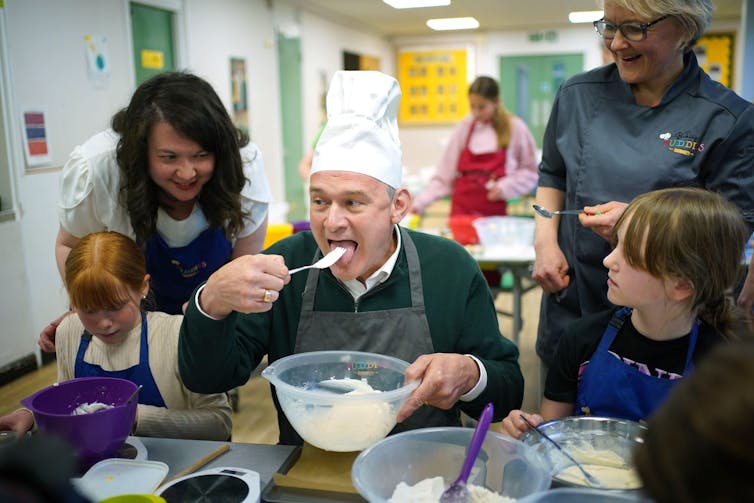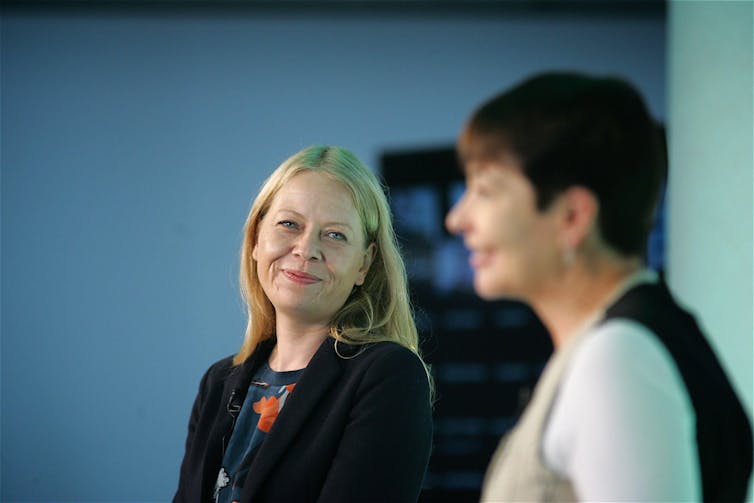With polls predicting huge losses for the Conservatives and huge gains for Labour, the election campaign so far has focused on the battle between the two biggest parties in Westminster. But the parliamentary dynamics are exceptionally fluid this year. Here’s a summary of where every party in Westminster currently stands – and where they are hoping to be after July 4.
Conservatives: 346 seats and everything to lose
Sunak’s Conservatives held 346 seats when he called the election. They started with 365 after the 2019 election but have lost 11 in byelections since then. Several other former Conservative MPs have defected to other parties and others have been suspended.
A hefty chunk of the party’s current MPs are standing down, leaving newly selected candidates to fight what is likely to be an incredibly difficult campaign for the party.
The Conservatives are almost guaranteed to be sitting on the opposition benches in the next parliament, with one recent poll suggesting they could fall to just 66 seats – their worst electoral performance ever. This could put them in dangerous territory. It would be a humiliation for Sunak if the party performed so poorly that it fell into third place behind the Liberal Democrats.
Against this backdrop, winning 150 seats or more would be a pretty decent showing.
Labour: 205 seats and hoping for 400
The Labour Party won 202 seats in the 2019 general election under its former leader Jeremy Corbyn. This has increased slightly since then, through a combination of defecting Conservative MPs and byelections. Labour ended the parliament with 205 seats.
The party’s victory in Blackpool last month, where Chris Webb won 58% of the vote, was the sixth time Labour won a byelection with a swing of more than 20% since 2019. This bodes well for election day, where Starmer will be keen to try to win a comfortable majority and, if recent polling is correct, more than 400 seats in the House of Commons.
Scottish National Party: 43 MPs and worried
The SNP have had some spectacular performances in recent general elections, bringing 56 MPs to the House of Commons in 2015, 35 in 2017 and 48 in 2019. But the party has struggled somewhat in the current parliament. It has lost three MPs to defections and the suspensions of Patrick Grady following sexual assault allegations and Margaret Ferrier for COVID rule-breaking shattered the SNP’s previously clean image in Westminster.
The SNP therefore heads into this election with 43 MPs. The party is battling two fronts, with the Alba party threatening to split the nationalist vote and Labour looking to win as many of Scotland’s 57 seats as possible.
Labour won Ferrier’s old seat in the Rutherglen and Hamilton West byelection with a 20% swing and polling suggests they will take many more seats from the SNP on July 4.
Liberal Democrats: 15 seats and wanting third place
The Liberal Democrats won 11 seats in the 2019 general election and this has since risen to 15 through four successful byelections. The party performed very strongly in recent local elections, gaining more councillors than Sunak’s Conservatives. Party Leader Ed Davey had a lot of fun over the first week of the campaign and won the party a lot of much needed publicity in the process.

Seats like Carshalton and Wallington, where the Liberal Democrats lost out to the Conservatives by just a few hundred votes in 2019, will surely turn yellow. With the SNP predicted to lose many of its Scottish seats, the Lib Dems will be hoping that they can reclaim their position as the official third party at Westminster.
Democratic Unionist Party: seven seats and struggling after scandal
The DUP won eight seats in 2019 but technically lost one when Jeffrey Donaldson resigned following sexual assault allegations. His seat in Lagan Valley has not yet been filled and will be hotly contested, particularly as Donaldson himself is not standing. DUP leader Gavin Robinson will have a tough battle in East Belfast against Alliance party leader Naomi Long.
Sinn Féin: standing aside in key seats
Sinn Féin won seven seats in 2019. However, in line with its abstentionist policy, the party’s elected representatives never took their seats in the House of Commons. The party has already confirmed that it will not field candidates in four of Northern Ireland’s 18 constituencies and will encourage its supporters to vote against Sunak’s Conservatives in those seats. This should work in the Alliance Party’s favour. One of Sinn Féin’s existing MPs – Michelle Gildernew – will also not be standing.
Plaid Cymru: hoping for gains on a new electoral map
Welsh nationalist party Plaid Cymru won four seats in 2019. They fell to just three MPs in 2020 when Jonathan Edwards was arrested for assault. Edwards, who has sat as an independent MP for most of the last parliament, has stood down, as has Hywel Williams, a hard working Plaid MP who has been in the Commons for over 20 years.
Plaid will be hoping to retain Williams’ Arfon seat, alongside those of the party’s Westminster leader Liz Saville-Roberts and Ben Lake, both of whom won with comfortable majorities in 2019 with Conservative candidates in second place.
Boundary changes mean that most constituencies in Wales have changed, but the party will be hoping to win back Edwards’s seat in the new Caerfyrddin constituency and perhaps to add Ynys Môn, held by Conservative MP Virginia Crosbie in 2019 with a relatively slender majority of just under 2000.
Alba: fighting its first election
Former Scottish first minister Alex Salmond’s pro-independence Alba party only formed in 2021, so this is its first ever general election campaign. It did however have two MPs in the last parliament, thanks to defections.
The addition of Alba to Scottish ballot papers threatens to split the nationalist vote and will make the election even more challenging for the SNP.
Social Democratic and Labour Party: aiming to hold two seats
Northern Ireland’s SDLP returned two MPs in 2019 and will hope to retain them. The party has been inconsistent in recent elections, and even lost all its seats in 2017.
The nature of Northern Irish politics and electoral pacts between unionist and nationalist parties makes it difficult to predict what will happen here. The SDLP has, however, committed itself to fielding candidates in every Northern Ireland constituency. Its leader Colum Eastwood won his Foyle seat by a landslide at the last election, as did his colleague Claire Hanna.
Alliance: hoping to take a key DUP seat
The centrist Alliance party, also specific to Northern Ireland, has never had more than one MP in the House of Commons. The party’s deputy leader Stephen Farry won the North Down seat for the party in 2019, though the DUP came a close second. Party leader Naomi Long will be trying to unseat the DUP Leader Gavin Robinson for the third time, having lost by 1,819 votes in 2019. She previously held the seat between 2010 and 2015.
The party has had growing success in the Northern Ireland Assembly, where it became the third largest party in 2022. Translating this into more Westminster seats will be tricky, but returning two MPs would be a good result.
Greens: targeting Bristol and Brighton
The Green Party’s one and only MP, Caroline Lucas, announced her resignation from parliament last year. She was the party’s first ever elected MP, holding her Brighton Pavilion constituency since 2010. The Greens are desperately hoping that former party co-leader Siân Berry can hold Lucas’s old seat.

The Greens are also eying up Bristol Central, where the party’s current co-leader Carla Denyer is standing against Labour’s sitting MP Thangam Debbonaire in what could be a real neck-and-neck fight. The party is already the largest party on Bristol Council. On a national level, it will be hoping to perform even better than the 2019 election, when it received a pretty respectable 860,000 votes. With record breaking local election results last month, the Green party could hit 1 million votes this time.
Reform UK: causing trouble for the Tories
Reform UK had one sitting MP in the last Parliament, following Lee Anderson’s defection from the Conservatives. Defections like this are how most small or new parties end up with House of Commons seats. Anderson won his seat with a 5,000 majority in 2019 and has a high profile thanks to his regular controversial contributions. But retaining his seat under a new party label will be very tricky.
Reform UK is fielding candidates across England, Scotland and Wales. It could take a substantial number of votes from the Conservatives, but the electoral system will probably mean that these votes are not concentrated enough to win more than the odd seat.
Workers Party of Britain: taking aim at Labour
This relatively new political party held just one seat in the last parliament, thanks to George Galloway’s Rochdale byelection success in February. Galloway will campaign to hold this seat and the party is hoping to woo Labour voters with its claims that Starmer is “indistinguishable” from Sunak. With a surprisingly long list of candidates for such a new party, it could prove something of an annoyance.

